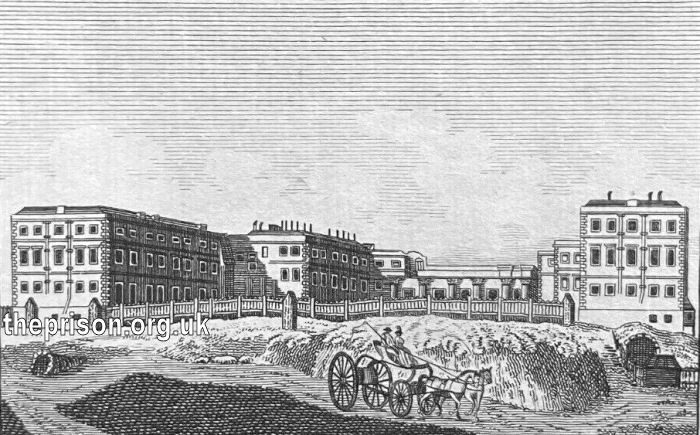Prisoner of War Camp, Winchester, Hampshire
In 1756, at the start of the Seven Years War between England and France, Winchester Palace, also known as the King's House, was chosen to house prisoners of war. The palace, on the site of the former Winchester Castle, was erected by Charles II, with Christopher Wren as architect. At Charles' death in 1685, the building was still uncompleted and saw relatively use until taking on the role of a prison.

The King's House, Winchester, c.1760.
At various times between 1756 and 1791, the palace held French, American, Spanish and Dutch prisoners, all captured during the various colonial wars of the time including the American War of Independence.
Prison reformer John Howard visited the site on two occasions. In 1784, he wrote::
There were a thousand and sixty-two French prisoners in the prison at Winchester, March 2, 1779. The wards are lofty and spacious. The area large. The meat and beer were good: but the bread (being made with leaven and mixed with rye) was not so good as that at Bristol. (I particularly observed the bread; for in France it was remarkably good and well baked. The prisoners are much happier when an attention is paid to this article.) If two or three of the rooms had been used as work-rooms, the health of the prisoners would have been promoted, and they would not have been indolently lying in their hammocks in the day-time; as I observed they were.
Several prisoners were confined in the dark hole.—Forty days confinement on half allowance, in order to pay ten shillings to those that apprehend them after escapes, seems to be too severe a punishment. On such occasions, the observation of the worthy magistrates at Bern always occurs to my mind, "that every one must be desirous of regaining liberty."
The hospital wards were lofty, and upwards of twenty feet wide. Each patient had a cradle, bedding and sheets; and the surgeon paid them great attention.
Feb. 26, 1782, the prison was cleaner than at my former visit, and there were many improvements in the wards and courts. The well was in order. The number of prisoners was three hundred and twenty-eight French, three hundred and forty nine Dutch, and seven hundred and thirty Spanish, besides in the infirmary, nine French, thirty-nine Dutch, and thirty-seven Spanish.—On inquiring for the attentive surgeon, I was sorry to hear, he had died of the gaol-fever, which was fatal to many in this prison.
In 1792, the palace was used temporarily to house of religious refugees who had fled France as a result of the revolution. In the same year, British soldiers were billeted there for the first time. The first floor of the building, which had originally housed banqueting rooms, was divided into two levels to increase the building's capacity. For just over a century, the palace formed the core of what became known Peninsula Barracks site. That ended on the night of 19 December 1894 when the building was devastated by fire. It was subsequently demolished and two new barrack buildings were constructed, though in a similar style to the Wren building. The site's used as an army barracks continued until 1986. In the 1990s, the buildings were converted into flats.
Records
Note: many repositories impose a closure period of up to 100 years for records identifying individuals. Before travelling a long distance, always check that the records you want to consult will be available.
- The National Archives, Kew, Richmond, Surrey, TW9 4DU. Holding include petitions from French prisoners-of-war (1779-80).
- The National Archives, Kew, Richmond, Surrey, TW9 4DU. Has a wide variety of crime and prison records going back to the 1770s, including calendars of prisoners, prison registers and criminal registers.
- Find My Past has digitized many of the National Archives' prison records, including prisoner-of-war records, plus a variety of local records including Manchester, York and Plymouth. More information.
- Prison-related records on
Ancestry UK
include Prison Commission Records, 1770-1951
, and local records from London, Swansea, Gloucesterhire and West Yorkshire. More information.
- The Genealogist also has a number of National Archives' prison records. More information.
Bibliography
- Higginbotham, Peter The Prison Cookbook: A History of the English Prison and its Food (2010, The History Press)
- Brodie, A. Behind Bars - The Hidden Architecture of England's Prisons (2000, English Heritage)
- Brodie, A., Croom, J. & Davies, J.O. English Prisons: An Architectural History (2002, English Heritage)
- Harding, C., Hines, B., Ireland, R., Rawlings, P. Imprisonment in England and Wales (1985, Croom Helm)
- McConville, Sean A History of English Prison Administration: Volume I 1750-1877 (1981, Routledge & Kegan Paul)
- Morris, N. and Rothman, D.G. (eds.) The Oxfod History of the Prison (1997, OUP)
- Pugh R.B. Imprisonment in Medieval England (1968, CUP)
Links
- Prison Oracle - resources those involved in present-day UK prisons.
- GOV.UK - UK Government's information on sentencing, probation and support for families.
Except where indicated, this page () © Peter Higginbotham. Contents may not be reproduced without permission.



